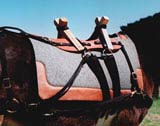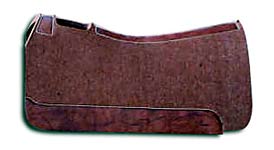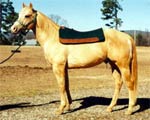|
Advantages of Wool for Horse Tack
Wool, The Natural High Tech Material by Mike Easton 5 Star Equine Products
Content Review – DR. Joyce Harman, DVM
In the equine world it seems that each year we are presented with new ideas about training, health
care requirements, and tack. Some of it is a new twist to old ideas or a new twist with a new idea or simply nothing has changed – just a marketing ploy.
Technological advancements in the fields of chemistry and physics created many materials. These
materials seem to have endless benefits, as long as the application is correct and does not create harm. Open and closed cell foams are some of the modern space aged materials, but when
applied to the equine world are they correct?
The design intent of foam was to provide a new material for compression protection, using
inorganic raw materials. And a high percentage of these foams came as a result of the NASA
space program. When various individuals decided that these materials could have beneficial use
in the equine industry, product development arose out of an idea, which was good in principle only. In reality the new product was developed and marketed without testing by reputable
scientific sources to prove whether the product had natural therapeutic benefit and structural fit for
the intended activity. Instead these new product developers presented new products to the public
based on personal bias and testimonials. And in most instances profit margins and retail cost became the selling points.
One such incidence of product abuse has been in the area of saddle pads. High tech fibers, open
and closed cell foams, air filled pockets and layered combinations. These materials could be
presented in bright colors, soft to the touch, and have a feel of real comfort. These became
instantly popular because individuals involved in the show world could provide additional flash and
those not involved could have the same flash at less expense. Companies with access to large sums of marketing dollars could now be a driving force.
But in the age of modern miracle fibers and foams, scientific research supports that the almost forgotten fiber made by God still remains the original high-tech fiber. That material is WOOL.
The old-timers in the tack world used wool for years and had great success with it. Even the
avid modern day hunter has found that all the high tech fiber in the world does not surpass the
attributes of wool. Especially when it comes to socks, which is equivalent to the saddle pad in the equine world.
Today’s sportsman and equine owner are learning what sheep in the hottest and coldest climates
of world have known for thousands of years. When it comes to thermal-regulation and all-around protection performance, WOOL, the original high-tech fiber, is still unmatched.
The secret to wool lies in its complex cellular structure. Each hollow strand is engineered to trap
heat while resisting the buildup of moisture. Every follicle of wool is made up of a hydrophobic
(water-hating) exterior shaft and a hydrophilic (water-loving) inner core. This gives wool the unique ability to wick perspiration (sweat) away from the body and at the same time shed
moisture. This is why you can’t mop up spilled water with a wool cloth. And at the same time it
is why wool can absorb up to 30 percent of its own weight in perspiration/water vapor; cotton can absorb up to only 8 percent of its weight; synthetic usually less than 5 percent of its weight
and has very limited wicking ability.
A contradiction certainly seems apparent with wool not being able to mop up spilled water and
yet is still able to absorb 30% of its weight in perspiration/water vapor. Moisture transport in
textile materials is the same as wicking in capillaries. Capillary wicking is determined by two
fundamental properties of the capillary: Its’ effective diameter, and the surface energy of its’
inside face (such as the inner core of a wool fiber – see diagram above). The smaller the diameter or the higher the surface energy, the more readily water moves up the capillary.
This combination of both diameter and surface energy differences results in a strong wicking
gradient between the inside and outside of the felt. This allows for sweat to be picked up from the
skin and be pulled to the outside face of the wicking gradient (outer edge and surface of the pad).
When textiles materials are woven together the spaces between fibers create a pattern that
functions like capillaries. The closer fibers are packed together in fabric, yarns or felt, the smaller
the apparent capillary diameter, and the more readily wicking can occur. In other words, it is just
like two magnets, the closer they get to each other with the correct polarity the stronger their
magnetic attraction. Other fiber properties that play a supporting role in capillary action are fiber diameter, cross-section structure, crimp and stiffness.
Because of the structure of wool, the surface energy (measure of attraction between water and the
internal surface of the capillary) is very high. This hydrophilic – “water-loving” component is the
aspect that delivers sweat and heat away from horses or mules backs and through the pad.
 The activity of the horse and rider produces “sweat”. The sweat is the
horse’s means of eliminating heat. This sweat is transferred away from the skin as a result of the contact with the wool pad. The
capillary action of an individual wool fiber, plus the compacted density of wool then distributes the moisture throughout the pad. Open and
closed cell foams have no wicking ability and simply TRAP MOISTURE AND HEAT. The activity of the horse and rider produces “sweat”. The sweat is the
horse’s means of eliminating heat. This sweat is transferred away from the skin as a result of the contact with the wool pad. The
capillary action of an individual wool fiber, plus the compacted density of wool then distributes the moisture throughout the pad. Open and
closed cell foams have no wicking ability and simply TRAP MOISTURE AND HEAT.
The “hydroscopic” aspect (moisture adjustments in response to changes in humidity) of natural
fibers is greater than that of synthetic materials, but it is not relative to any arguments that relate to the strength of natural fibers for moisture transfer in saddle pads.
Wool’s unique ability to deal with perspiration is ONE OF THE IMPORTANT components of limiting sores or the severity of a sore from a pressure point of an improperly fitted saddle or piece
of tack. Wool’s ability to wick sweat away from the body leaves the skin dryer and cooler than
other materials. Under a saddle, the primary problem is one of constant pressure in areas where
the saddle fits poorly. Pads of a variety of materials are often used to try and alleviate these
pressure points with no thought given to heat removal. The problem with most materials is that
pressure is transferred through the pad to the horse’s back and is often made worse after adding the pad.
Another IMPORTANT aspect of wool is the ability of a one-inch thick piece of wool felt to contain and limit pressure points. When there is a pressure point, damage to the underlying skin
and muscle occurs. Swelling of the skin, and edema or fluid under the skin or in the muscle,
occurs as the bruising causes fluid to leak out of the cells. When you eliminate bruising, you eliminate the swelling and pain that goes along with it.
In humans, wool has long been known for its ability to prevent blisters.
Blisters are formed from friction, and sometimes from pressure and friction together. During blister
formation, heat can build up, and it is known that wool reduces the severity of blisters by dissipating heat and pressure.
The point being, wool socks can’t eliminate the blister, but it will reduce the initial impact and
severity of the injury before one decides to do something about it. NOTHING replaces a shoe
that is correctly fitted, but we can’t always afford to replace shoes once the mistake has been
made, so we must do the next best thing – pad our feet correctly. Also, NOTHING replaces a correctly fitted saddle!
Synthetic materials, fibrous, open and closed cell foams, trap heat and do not wick and increase
the chances of heat related pressure sores. Also, they have limited compression protection. Their
strength lies in ease of cleaning, reduced saddle slippage in some cases and colorful patterns.
Unlike synthetic materials, wool fiber contains hundreds of tiny waves, called crimp, creating the
millions of air pockets that give the fabric its insulating properties and ability to breath. It is this
same component that allows wool to stretch up to 50 percent when wet, 30 percent when dry
and still bounce back to its original shape. It is this natural physical property that makes wool such a superior and beneficial compression protector.
If “open and closed cell” foams are stretched, they begin to break down immediately because
their molecular structure has memory constraints of less than 5% before they begin to break down and tear apart. These same materials also break down much quicker than wool when subjected
to heat, sweat salts and pressure. Despite the influx of new fibers and foams being introduced into
the equine world, WOOL continues to hold its own and be a main stay for top saddle makers and equine professionals that care about their animals well-being.
 How do we know this miracle fiber, WOOL, and
in particular WOOL processed into felt, is what it is cracked up to be? Dr. Joyce Harmon, D.V.M., noted Washington D.C. equine specialist, tested
saddles for correct fit and the best pad materials. Dr. Harmon’s research used similar testing procedures as used by Dr. Michael Collier, D.V.M
. from Oklahoma State University, when he was hired by Professional Choice to develop their Air Ride pad. Her conclusions for pad material,
and saddle fit and placement that provides complete equine protection, came only from a desire to benefit the animals. How do we know this miracle fiber, WOOL, and
in particular WOOL processed into felt, is what it is cracked up to be? Dr. Joyce Harmon, D.V.M., noted Washington D.C. equine specialist, tested
saddles for correct fit and the best pad materials. Dr. Harmon’s research used similar testing procedures as used by Dr. Michael Collier, D.V.M
. from Oklahoma State University, when he was hired by Professional Choice to develop their Air Ride pad. Her conclusions for pad material,
and saddle fit and placement that provides complete equine protection, came only from a desire to benefit the animals.
Through research, Dr. Harmon used the Forced Sensory Array machine just like Dr. Collier. They found pressed wool felt with high virgin wool content providing the best compression,
wicking ability and heat protection (reduction) of all materials on the market today.
Dr. Harmon’s original research stemmed from years of studying the correct mechanics of saddle
fitting and bio-mechanics of saddle placement. In a nutshell, what they found and what Dr.
Collier pointed out later was, a “Shoe is to Sock” as “Saddle is to Pad” analogy. Without putting
a correctly fitted saddle with a correct type of pad, no horse, mule or donkey is free from compression related injury that stems from saddle pressure points.
When pads are added under a saddle, the saddle must still fit the horse with the pad in place. If a
saddle basically fits with the pad, then a pad can enhance the situation. If a saddle is too narrow,
no pad will solve your problem any more than a thick sock will correct the fit of those pinching
dress boots you have in the back of your closet. If a saddle is a bit too wide, a thick pad can
really help the situation, IF it is made from material that will not compress much (wool and some of the dense types of foam). However, if a saddle is very much too wide, it will continue to tip
forward through any pad.
So how can you tell what is going on with your pad and saddle? Saddle up your animal with its
new pad, making sure to seat the pad by pulling it up into the saddle gullet and off the animals’
withers. Next, take a 20-30 minute ride that allows the animal to heat up. Now stop and check
to see how well the saddle and pad have stayed in place. Remove the saddle and pad, checking
the sweat marks on the underside of the pad. What you would like to see is a fairly even sweat pattern across the entire pad.
If your saddle fits worse after adding a pad, then it means the pad is incorrect for your saddle,
usually it is too thick. However, wool felt can require at least one hour of heated riding to seat
and form to saddle and animal conformation correctly. So many riders today insist on double
padding, but if one remembers the “shoe-sock” concept, two socks in a shoe is just like two
pads under a saddle. Some aspect of the sock or pad is always slipping or moving around. This
slippage creates or exacerbates pressure point problems and takes away from the close contact feel of a good saddle fit, minimizing the horses’ comfort and the riders feel.
If your horse feels great with the new pad, still be alert for old behavior issues for the next 6
months. A new pad may feel great initially, but pads have been known to cure one problem and
simply transfer it to a new area on your horse’s back, and it takes a while for that new spot to become sore.
The cure for all these problems is quite simple. Noted horseman, Ray Hunt says, “It’s what
happened before that you didn’t want to have happen.” Use common sense; don’t get caught up
in every new gimmick without checking out the background from several sources. Endorsements
don’t make a product, because most endorsers are paid for their association. Use a good
reputable saddle maker that knows and understands correct saddle fit. Check their background
and whom they trained under. Find a time of year that your horse is in good using condition so
that the saddle maker can fit your animal when it is not over fat or too thin! Lastly, when
considering pads, consider seriously “would I wear it” as a “sock” or “underwear”? If not, then
why in the world would I submit my animal to those same materials?
5 Star Equine Products has developed a reputation for creating 100% wool felt saddle pads that
are beneficial to the horse because of their excellent fit and superior ability to wick the heat and
moisture away from the animal. 5 Star pads have the highest virgin wool content of any pad on the market today, at 92% with an 8% reworked wool content. This is the reason for it’s superior
qualities that make for a comfortable animal that will give you their best performance! Also, 5
Star’s user friendly pads will outlast any other pads, thereby providing maximum $ value for your
investment. To see these pads online, check out www.5StarEquineProducts.com or go directly to order online from one of these dealers
 Contact:
5 Star Equine Products Contact:
5 Star Equine Products
4589 Highway 71, South
Hatfield, Arkansas 71945
Phone: 870-389-6328
Email: fivestarequine@alltel.net
Website: www.5StarEquineProducts.com
|